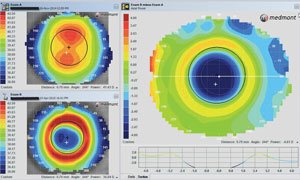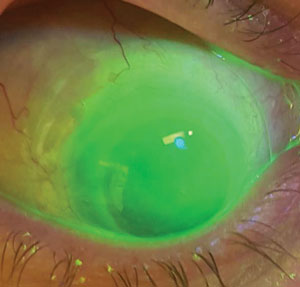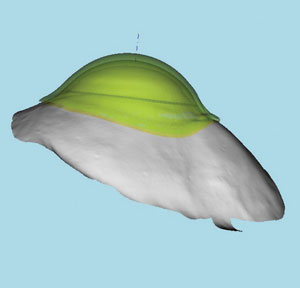Visual freedom, better quality of life and—in many cases—improved quality of vision are just some of the benefits many wearers gain from contact lenses as compared to spectacles. With the ongoing refinement of contact lens designs, practitioners now have more options than ever to fit even the most astigmatic presbyope or severe case of dry eye. Technology has evolved in tandem with the lenses themselves, offering more advanced lens design and fabrication methods. This article addresses how today there truly is a lens for every patient.
Soft Lenses
Lathe-cutting of custom soft toric and soft toric multifocal lenses was first introduced with the approval by the Food and Drug Administration of the Definitive 74 silicone hydrogel lens material from Contamac. This process results in highly oxygen permeable lenses in practically any lens parameter. One relatively new example of this design is the Intelliwave multifocal toric (Art Optical), a center-near simultaneous vision soft lens with a multi-aspheric front surface for the correction of vision at all distances. This lens is an aberration-control design that can be fit empirically.
 | |
| Fig. 1. Innovations in software are also improving our ability to fit custom lenses. Here, an EyeSpace-created difference map of the Forge orthokeratology design is used to successfully fit a 4.5D myopic patient. |
The C-Vue Advanced HydraVue toric multifocal (Unilens) is another example. Replaced monthly, it can be made in virtually any lens parameter. Eye care practitioners can also specify the base curve radius, overall diameter, sphere power, cylinder power and axis, add power and zone size.
New innovations in custom soft lens designs are not limited to the astigmatic presbyopic patient. Recently introduced custom soft keratoconic designs such as the KeraSoft IC (Bausch + Lomb) and NovaKone (Alden Optical) offer a made-to-order lens option available in almost every conceivable power and cylinder axis. KeraSoft is available in the Definitive silicone hydrogel material (Art Optical) with aberration control optics, while NovaKone uses a 54% hydrogel material. A quarterly replacement schedule is recommended for both lenses.
Scleral Lenses
Scleral lens use has continued to increase in recent years as a result of the high quality vision, lens stability and comfort they provide for patients with irregular corneas and dry eye. Although the original design has been available for decades, new trends include the development of varying diameters, materials and back surface geometries.
There are several new designs of note on the market. The Zenlens (Alden Optical) is available in both prolate and oblate designs with either a 16mm or 17mm diameter. With this lens, practitioners are able to modify a single parameter (i.e., base curve, limbal clearance curve or peripheral curves) at a time. Toric peripheral curves can be ordered, as well as a front surface toric correction if needed.
The Europa Scleral (Visionary Optics) is a second-generation Jupiter scleral lens design with a large optical zone, mid-peripheral reverse curve and an enhanced haptic profile for a better lens-to-sclera fitting relationship. It is indicated both for irregular cornea correction and for patients with ocular surface disease.
Tru-Form Optics has the DigiForm 15mm scleral lens which is available in five primary designs for patients with either keratoconic, LASIK, RK, post-corneal graft or healthy corneas, as well as toric and quadrant-specific versions. The DigiForm 18mm diameter version incorporates laser markings on the front surface corresponding to the fitting zone of the back surface.
Peripheral toricity is also an important and increasingly popular feature of the newer scleral lens designs. The Custom Stable Elite lens (Valley Contax) is one such design.
 | |
| Fig. 2a. The EyePrintPro design exhibits the mold accompanied by the resulting lens shape (in green). | |
 | |
| Fig. 2b. A model of the lens on the eye. |
Of course, scleral contact lenses are not just for compromised eyes; an increasing number have been introduced for astigmatic and presbyopic patients as well. These include the Onefit P+A lens for astigmatic patients and Reclaim HD aspheric front surface multifocal for presbyopes, both from Blanchard Contact Lens. The Elara Scleral (Visionary Optics) is another example of a scleral lens with a prolate design that has clinical applications for both healthy eyes and dry eye patients.
Gas Permeable Multifocal Lenses
The introduction of front surface aspheric multifocal or aspheric-concentric combination designs, capable of providing high add powers, has made GP multifocals the “go-to” lenses for presbyopes interested in clearer vision. The MPower lens (Art Optical), a simultaneous vision multifocal design, uses anterior surface eccentricity control to provide an extreme power change generated within the lens' central 5mm of the lens.
New progressive segmented, translating GP multifocal designs have also been introduced as well that allow not only uninterrupted vision at distance and near but also correction at all distances. The SpectraVue by Tangent Streak (Firestone Optics) multifocal lens has the distance correction in the upper section of the lens that combines with a crescent-shaped middle segment to provide a progressive intermediate power change, similar to a spectacle progressive addition lens but without a limiting channel.
Several other relatively new GP multifocal lens designs provide the presbyope with vision correction at all distances. These lenses complement other multifocal and translating designs introduced in recent years, including the TriVA design from ABB Optical and the Expert Progressive lens (Essilor, Art Optical), both of which can be ordered empirically based on refractive and anatomical information.
Hybrid Lenses
Hybrid contact lens designs also continue to improve. Problems with first and second generation designs include limited oxygen transmission, tearing of the junction between the center GP and soft skirt and a tight fitting relationship; more recent designs have since addressed these issues.
One example, the UltraHealth design (SynergEyes), uses a reverse geometry vault system to accommodate a range of prolate and oblate corneas. In this lens, the oxygen-permeable central GP section is joined to the peripheral silicone hydrogel skirt with a covalent bond to minimize tearing. A second lens from the same company, the UltraHealth FC, is designed specifically for oblate corneas, including post-refractive surgery patients and patients with pellucid marginal degeneration. SynergEyes is continuing to work on solving the third issue.
Custom Tinted Lenses
While tinted lenses are often considered cosmetic in nature, patients with traumatic eye injuries or congenital iris anomalies can also benefit from these custom designs. One company, Orion Vision, specializes in custom tinting of existing contact lenses supplied by ABB Optical and Alden Optical.
Myopia Progression
While off-label, interest has risen in the use of corneal reshaping contact lenses to slow myopia progression. Several studies on young progressive myopes wearing orthokeratology lenses overnight indicated axial length growth was significantly slowed in comparison to those who wore contact lenses and spectacles.1,2 Other research evaluating peripheral plus power soft lens designs found regular wear resulted in an average of 50% less myopia progression and a 58% reduction in axial length progression, compared with non-peripheral plus power soft lens wearers.3 Peripheral plus bifocal designs have also demonstrated an effect on myopia, albeit less significant and with some vision compromise.4-6
Lens Design Software
In addition to the lenses themselves, new software programs are helping eye care practitioners achieve more successful fits. Recently available in the US, EyeSpace imports data from the corneal topographer and uses this information to design a rigid lens. It has notable applications in designing specialty lenses (Figure 1).
“I have been using EyeSpace for a variety of corneal reshaping patients,” says Michael Lipson, OD. “It has worked well to attain centration in some difficult cases. Using it to design corneal reshaping lenses adds a high degree of precision and control to the effect and predictability to the process.”
The use of three-dimensional mapping to help fit scleral lenses is also gaining popularity, says Greg DeNaeyer, OD. “Corneo-scleral topography and 3D mapping will significantly advance scleral lens fitting. Rather than relying on guesstimates from diagnostic lenses, corneo-scleral topography and scleral lens fitting software will allow practitioners to virtually fit scleral lenses that are customized for each particular eye.”
The sMap3D corneo-scleral topography system (Precision Ocular Metrology) is one such example that uses a structured light approach to obtain micro precision measurements of the cornea and sclera.
Developed by Christine Sindt, OD, and manufactured by AVT, EyePrintPro is another 3D mapping technology that creates a prosthetic optical shell unique to the shape of the patient’s eye (Figures 2a and 2b). “The EyePrintPro has given me the opportunity to fit extremely difficult patients with success,” says Stephanie Woo, OD. “The 3D scanner used to create the lens enables the practitioner to achieve a near-perfect tear layer between the cornea and the EyePrint, which results in a precise fit and great vision. You can also customize the EyePrint to incorporate decentered optics or prism within the lens, which gives the patient a truly unique and custom visual device.”
No Limits
The introduction of innovative new designs, supported by highly advanced software and manufacturing technology, has resulted in exciting new materials and designs in practically any lens parameters for almost any patient who is interested in contact lenses. This does not mean that further research is not warranted; rather, this is simply the next step, and we look forward to see what next year will bring.
Dr. Bennett is a professor of optometry and assistant dean of student services and alumni relations at the University of Missouri-St. Louis College of Optometry. He is also the executive director of the GP Lens Institute. The author wishes to acknowledge the following: Peg Achenbach, OD (SynergEyes), Josh Adams (Valley Contax), Greg DeNaeyer, OD, Richard Dorer (Blanchard Contact Lens), Cassandra Gordon (Visionary Optics), Mike Johnson (Art Optical), Michael Lipson, OD, Kelly McKnight (Unilens), Daren Nygren (Custom Craft Lens Service), Keith Parker (AVT), John Patterson (Orion Vision), David Rusch (Firestone Optics/Diversified Ophthalmics), Ann Shackelford (ABB Optical), Bill Shelly (Alden Optical), Jan Svochak (Tru-Form Optics), and Stephanie Woo, OD.
1. Cho P, Cheung SW, Edwards M. The Longitudinal Orthokeratology Research in Children (LORIC) in Hong Kong: A pilotstudy on refractive changes and myopic control. Curr Eye Res 2005;30:71-80.
2. Walline JJ, Jones LA, Sinnott LT. Corneal reshaping and Myopia Progression. Br J Ophthalmol 2009;93:1181-1185.
3. Holden BA. The future of myopia management with contact lenses: Where to from here? Possibilities and probabilities. Presented at the Global Specialty Lens Symposium, January, 2015, Las Vegas, NV.
4. Walline JJ, Greiner KL, McVey ME, Jones-Jordan LA. Multifocal contact lens myopia control. Optom Vis Sci 2013;90:1207-1214.
5. Holden BA, Sankaridurg PR, de la Jara P, et al. Decreasing peripheral hyperopia with distance centre relatively plus powered periphery contact lenses reduced the rate of progress of myopia: A 5 year Vision CRC study. E poster 6300, ARVO 2012.
6. Anstice NS, Phillips JR. Effect of dual focus soft contact lens wear on axial myopia progression in children. Ophthalmology 2011;118(6):1152-1161.


